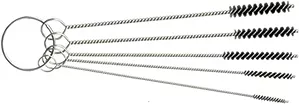Before we begin - this will not be a guide written by a master for beginners. I'm far from being a master of an airbrush. But I am a self-taught practitioner of it and some of the things I've learned myself I was not able to find in any of the guides I'd read. And I read a lot.
So, you want to start your adventure with the airbrush? Good for you. Great, even. The airbrush is an awesome, versatile tool. It will perform some amazing jobs, you will be, eventually, able to achieve some great effects.
But it has a learning curve. It is a sizable investment. Also, some people dismiss it entirely as a "get-done-quickly" kind of tool. Some even go as far as to compare its usage to dipping the models in wood polish. World-view and idiosyncrasies aside, I've found the airbrush to be useful at first and indispensable afterwards.
So, let's go over the basics. I'm not going to explain terms like single-/double-action or feed type, you can easily find these in other sources and you're bound to have heard them if you want to buy an airbrush. Instead, let's focus on the usage.
First things first - get a double action, gravity feed airbrush. These are more expensive than single action ones (the Citadel spray gun being a notable exception), but they will perform all the tasks single-actions are capable of and more. Paasche and Harder & Steenbeck are very good brands that still maintain a decent price for some of the simpler models. Don't go into the high end at first, even if you can afford it: Iwata, for instance, is out of the question for beginners in my opinion. If you have money to spend, get a compressor. Some companies sell starter sets: an airbrush and some basic paints. These are usually a very good option. I know Vallejo does this.

Get a dedicated air compressor for airbrushing. This is the part that turns most people away from airbrushing altogether. Don't bother with canned air, it's a huge waste of money. Compressors can be a bit noisy and they are pricey, but in the long run they pay off several times their worth. After you get the hang of airbrushing and want to do it more, you can go for a more powerful, industrial compressor with a bigger air tank, but that's way ahead on the road. Stick to dedicated compressors for airbrushing for now.
 |
| Nozzle cleaner. Your airbrush will love you. |
Get yourself a set of proper cleaning tools: a paint remover/airbrush cleaner, a nozzle cleaner and some cleaning wires. Airbrushes need maintenance and care. They need regular cleaning and they will perform admirably for a long time, even the Chinese "pseudo-Iwatas".
The cleaning wires are a necessity. Once in a while it is simply obligatory to disassemble your airbrush and clean it thoroughly. Paint can gather in the weirdest of places, but the wires, with the aid of an airbrush cleaner, will get to these places.
The cleaning station falls under the "not necessary, but very handy" category It's essentially a fancy glass jar, but it prevents your workstation from getting uber-messy when cleaning the airbrush and your body from inhaling all these great fumes of paint thinner. It also doubles up as a great airbrush holder and a water pot. It works like a filter - you pour water into the jar, screw on the lid and put your airbrush into the rubber-rimmed hole. When you clean the 'brush, the bad stuff stays in the water and doesn't flow away. Really, a very handy piece of equipment and - in comparison with the rest - a pretty inexpensive one to boot.

Paints, duh. Dedicated brands for airbrushing exist; Vallejo Model Air comes to mind as the most prominent, but there are many others, not only acrylic. My advice is to get one or two colors of airbrush paint to get the idea of how the dilution and saturation should be. You can of course use normal paints (and primers, and varnishes, and alcohol for pigment sealing) in airbrushing, therefore paint thinner is an absolute must. As far as priming goes, Vallejo (I swear, they don't pay me a dime!) makes a great primer in a couple of interesting colors. And the best part is you don't need to dilute it!
As a final note before we get to actual painting practice: the above seems like a lot, I know. It is a big amount of stuff. But airbrushing is just one of those things that you have to invest a lot into at the beginning, but lesser and lesser so as you progress. I've purchased all of these over the period of two years, always thinking "why the hell haven't I done it sooner?!".
Next time, we'll go over the basics of actually painting something. Stay tuned!
LEGAL DISCLAIMER: All the images used are copyright of their respective owners. Used without permission for demonstrative purposes only. No challenge to their status is intended.












































.JPG)
.JPG)